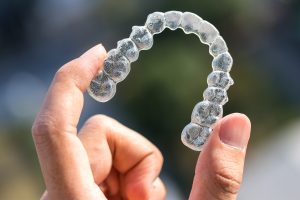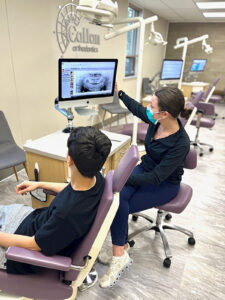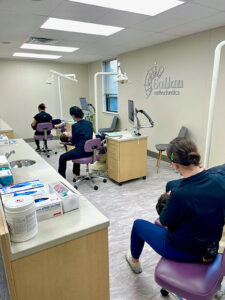Your Next Orthodontist Appointment
Whether it’s your second visit with us or your twenty-second, we at Callan Orthodontics are here to help you feel comfortable.

 Getting Braces
Getting Braces
Before your orthodontic appointment
Before getting braces, it’s important that you thoroughly clean your teeth. Plaque can interfere with the brackets’ ability to stay on your teeth, as well as increase the chance of cavities if they become trapped. If your teeth aren’t sufficiently clean when you arrive at your appointment, your orthodontist will clean them with polishing paste.
At your orthodontic appointment
Once your teeth are clean, you’ll receive your braces. Although the specifics can differ depending on the type of braces you’re getting, the process usually involves attaching the brackets to your teeth and placing a wire. This process is painless, requires no numbing medication or drills, and takes between 1-2 hours, although there’s no definite time frame.
After your orthodontic appointment
Once you have your braces, it’ll likely be a week or two before you’re accustomed to them. In the meantime, you can ease any discomfort with over-the-counter pain medicine. Be sure to avoid sticky foods such as taffy and hard, crunchy food such as popcorn, even after you’ve adjusted—not only can they irritate your mouth and get lodged in your brackets, but they can also damage your braces.
Eating with Braces
Adjusting to eating with braces can take some time, but with a few simple changes, you can enjoy your meals without worry! Stick to softer foods like pasta, yogurt, and steamed vegetables – especially in the first few days after getting your braces. Avoid hard, sticky, or chewy foods that might damage your braces or get stuck in the wires. Cutting your food into smaller pieces can also make eating more manageable and comfortable!
Welcome to Braces!
Maintaining and Cleaning Braces
There’s more to having braces than just avoiding popcorn—to make them last, you have to know how to clean your braces well. Improperly cleaned braces trap food particles in your mouth, which can lead to cavities, irritated gums, and staining.
Luckily, cleaning teeth with braces isn’t very difficult. Brush for at least three minutes after every meal and snack, angling the bristles to reach the crevices of your brackets. Be sure to focus on the spaces between your braces and your gums to minimize irritation. Floss at least once a day as well—you can do so with traditional floss, flossing sticks, or with a water-flossing tool.
Even if you know how to maintain your oral hygiene with braces, it’s also important to schedule regular dental cleanings to get your teeth professionally cleaned. These should be scheduled every six months or at your regular dentist’s recommendation for the best results.
 Subsequent Orthodontic Appointments
Subsequent Orthodontic Appointments
No matter how well you’re taking care of your braces, you’ll need to schedule follow-up appointments with your orthodontist before you can get them removed.
When and Why Do I Need to Get My Braces Adjusted?
There’s no definite “when” for getting your braces adjusted; every mouth is different, and it’s ultimately up to your orthodontist to decide how often they should see you. However, on average, you’ll get your braces tightened every 4-8 weeks. Your orthodontist will discuss the scope of your treatment plan beforehand, so you’ll know what to expect in terms of adjustment frequency.
Braces work by applying slow, consistent pressure to your teeth, shifting them over time. If your braces aren’t regularly adjusted, this pressure fades, which means your teeth stop moving. Your orthodontist will change your braces wire or adjust them so that they apply pressure from different angles to maximize their effectiveness.
In some cases, your orthodontist may recommend that you wear rubber bands (elastics) to align the jaws and ensure a proper bite. Wear these elastic bands as instructed to minimize discomfort and maximize effectiveness over time.
What Do I Do if My Braces Break?
If you’re careful about what you eat and clean your braces regularly, you should make it through your treatment with your appliance intact. However, broken brackets do still happen—and that’s okay!
In the event of a broken braces wire or bracket, the most important thing to do is not to panic. Dr. Callan will fix them up as good as new! Remember, accidents happen, and at Callan Orthodontics, there is never any additional charge for a broken appliance.
Before you call the office, check your braces to see how severe the damage is. Leave any wires that are still in place, and gently reposition those that are poking out with a cotton swab or dental wax. If a bracket is loose, secure it with orthodontic wax; if it’s fallen off completely, discard it. Once you’ve secured all loose ends, schedule an orthodontic appointment to get it professionally repaired.
Getting Braces Off
The exact amount of time you’ll spend with braces will vary depending on the severity of your orthodontic issues. On average, your braces can come off after 18-24 months. Your orthodontist will give you a final thorough examination before removing them, including X-rays. This is to make sure your teeth and jaw have shifted to their appropriate places.
Removing your braces isn’t the end of your orthodontic treatment, however. To keep your new smile straight, your orthodontist will transition you to a removable retainer. You’ll wear it full-time for anywhere between 3-6 months. From there, you’ll transition to wearing it at night, often indefinitely. This may seem like a lot of work for a straight smile, but trust us—it’s worth it!
Wearing and Caring for Your Retainer
Your retainer is key to maintaining your new smile! To ensure it works effectively, wear it as instructed by Dr. Callan. Clean your retainer daily with a toothbrush and mild soap, avoiding hot water that can warp the material. Always store it in its case when not in use to prevent loss or damage. Last but not least, remember to regularly check for signs of wear and bring it to your appointments for adjustments if needed.
Invisalign Patients

During your initial consultation, your orthodontist will discuss all available treatment options. One of these options may be Invisalign, a series of clear plastic trays used in place of traditional braces.
The process for getting Invisalign trays differs in several ways from traditional braces. First, you’ll have a consultation where Dr. Callan will thoroughly examine your mouth and jaw. This is where he’ll determine if Invisalign is an option for you. If it is, the next step is capturing a mold of your mouth and teeth. This is done digitally, quickly, and painlessly. This mold is used to create your Invisalign trays.
Several weeks after you receive your first tray, you’ll need to visit your orthodontist to make sure your teeth are shifting properly. While you’ll receive several different trays throughout your Invisalign treatment, you won’t need to schedule an appointment when it’s time to switch to the new one. Each tray lasts about 1-2 weeks on average, and you’ll be given a supply to last several weeks or months.
Invisalign invisible aligners are a popular orthodontic appliance due to their removable, unobtrusive design. While you should keep them in as much as possible (at least 22 hours every day), you can remove them to brush your teeth and clean the trays. You must clean them regularly, too—the trays can trap food particles against your teeth, increasing the risk of cavities.





